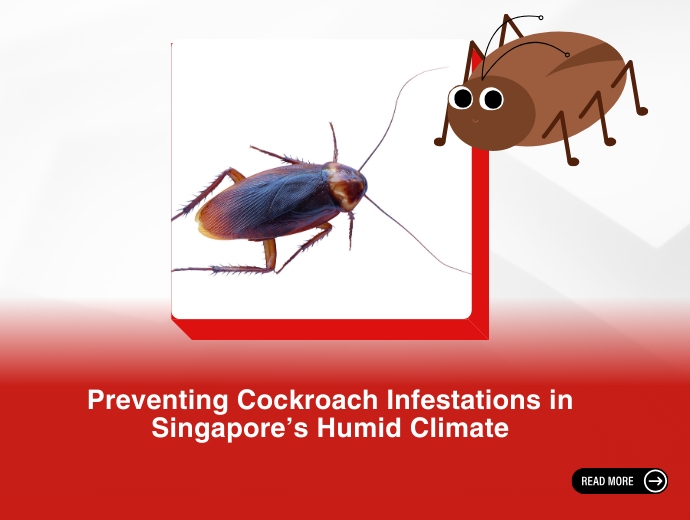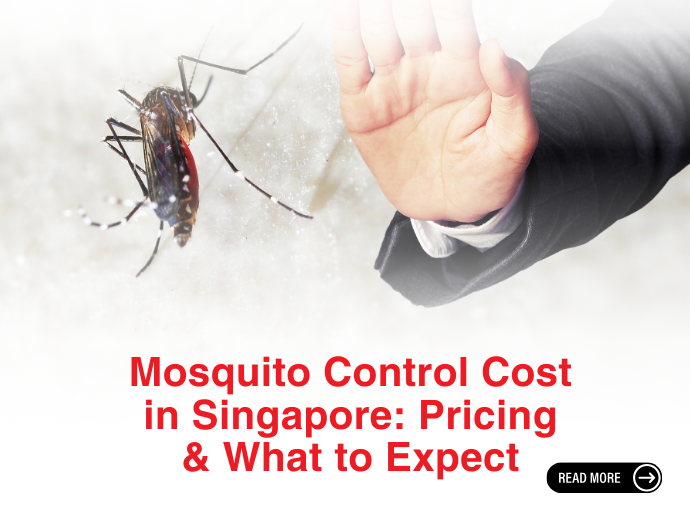Maintaining a healthy living environment involves pest control. In Singapore, there is a need for sustainable pest control practices to minimise the environmental impact and reduce the risks to human health. This article aims to provide an overview of sustainable pest control practices in Singapore and their benefits.
The Importance of Sustainable Pest Control
Traditional pest control practices can cause health issues and damage the environment. For example, the use of pesticides can lead to contamination of soil and water, and can be toxic to humans and wildlife. Additionally, some chemicals used in pest control can be harmful if inhaled or ingested. Traditional pest control practices involve the use of chemical pesticides, which pose a significant threat to the environment, human health, and non-target organisms.
Sustainable pest control practices aim to minimise the environmental impact while ensuring effective pest management. For example, reducing the use of large quantities of toxic chemicals on your premises is one way to support your sustainability agenda. It is believed that the use of toxic substances for pest control dates back to Sumerian times (2500 BC), when sulphur compounds were used to control insects.
Singapore is a tropical country with a humid climate, making it a favourable breeding ground for pests. Singapore's pest control practices have evolved from conventional methods to more environmentally friendly methods.
Pest Control Methods in Singapore
There are various methods used for pest control in Singapore:
Chemical Pesticides
Previously, the use of large quantities of chemical pesticides were extensively relied upon as the primary method for pest control in Singapore. Today, significant efforts have been made to minimise the use of chemical pesticides to mitigate their detrimental effects to the environment.Alternative and more sustainable pest control methods like using physical barriers, biological control, trapping and monitoring have been adopted to ensure effective pest management while reducing the overall environmental impact..
Biological Control
Biological control involves the use of natural organisms to control pests. For example, ladybugs may be introduced into an environment to reduce the population of aphids to minimise damage in gardens or on trees . This method is environmentally friendly and poses no risk to human health.
Physical Control
Physical control, as the name implies, employs tangible means to prevent pests from entering or establishing themselves within certain areas. For example, this could be as simple as sealing gaps or cracks in the structure of a building to prevent rodents or insects from gaining access. The use of traps is another important aspect of physical control. Different types of traps are designed to capture or kill specific pests. For example, rodent traps are used to catch rats that have already made their way into buildings. Insect traps, which often use pheromones or lights to attract the flying insects, are another example.
The strength of physical control lies in its preventative nature and its minimal reliance on harmful chemicals.
Pest exclusion, an integral part of physical control, is the practice of preventing pests from entering an area in the first place. It is a proactive method that involves creating a barrier against the pests before they can become a problem. This can range from structural modifications, like installing screens on windows, air curtains to prevent entry of pests such as cockroaches, flies or rodents.
Cultural Control
Cultural control is an effective method of pest management that often involves making changes to human behaviour and practices. In the context of Singapore, there are many ways cultural control can be applied to manage various pest populations effectively.
For instance, Singapore's tropical climate and dense urban population make it an ideal breeding ground for mosquitoes, which can transmit diseases like dengue and Zika virus. To manage mosquito populations, the National Environment Agency (NEA) of Singapore encourages residents to adopt the "5-step Mozzie Wipeout" method, which includes turning over water storage containers, changing water in vases regularly, and removing water from flower pot plates. These practices allow Singapore to manage pests effectively without disruptive or harmful methods.
Environmental Impact of Chemical Pest Control Services
It is possible to have several negative impacts on the environment from the excessive use of chemical pest control. This entails insecticides, herbicides, and rodenticides. This is largely because most pesticides are non-selective and affect organisms other than the pests they are meant to control.
Here are some of the key environmental impacts of chemical pest control:
Bioaccumulation and Biomagnification
Bioaccumulation and biomagnification are two related processes that refer to the build-up of substances, usually toxins, in organisms and through food chains.
Some pesticides are not easily broken down in the environment and can accumulate in organisms (bioaccumulation) or become more concentrated as they move up the food chain (biomagnification). This can lead to serious health problems in top predators, including humans.
Health Issues
Chemical pesticides used in household pest control pose a threat to human health, when used excessively or incorrectly. A pesticide is a chemical compound that is used to kill insects, rodents, fungi, and unwanted plants.
For example,too much chemical pesticide in their home can cause acute health effects such as stinging eyes and dizziness. Inhaling chemical pesticides can result in respiratory problems such as asthma and bronchitis. It may also cause skin irritation and rashes if they come into contact with the skin. Chemical Pesticides can also cause nausea, vomiting and diarrhoea. (source: WHO)
Damage to Biodiversity
Inefficient pest control practices can harm non-target organisms, reducing biodiversity. Not only are these beneficial species harmed directly by the pesticides they are also harmed through indirect routes, such as water contamination, runoff, residues, and consuming sprayed food. A 2014 study published in the Chemosphere examined the effects of different pesticides on a common insect predator. The decline of these insects is being observed consistently by researchers, attributed to both pesticide exposure and a general decrease in biodiversity.(Source: beyond pesticides)
Sustainable Pest Control Practices
Sustainable pest control practices aim to minimise the environmental impact while ensuring effective pest management.
Integrated Pest Management (IPM)
IPM is a sustainable pest control services that involves the use of biological, physical, and cultural control methods. This approach ensures that pest control is done effectively and sustainably while minimising the environmental impact.
Use of Natural Pesticides
Natural pesticides are derived from natural sources such as plants, bacteria, and minerals. They pose minimal risks to the environment, human health, and non-target organisms because they are selective in what pests they control. For example, biologicals such as insecticides containing Bacillus Thuringiensis Israelensis, a naturally occurring soil bacterium, is helpful because it specifically targets mosquito larvae and does not kill other beneficial insects like dragonflies.
Using Professional Pest Control Services
Trained Pest control professionals apply sustainable pest control practices effectively as it requires a different approach than traditional pest control methods.In Singapore, pest control professionals have to attend the Environmental Control Coordinator (ECC) training course.
The training will equip ECCs with the relevant skills in planning and implementing a wide range of environmental measures including cleaning and disinfection,waste management and other relevant environmental topics to effectively apply them in the field.
Benefits of sustainable pest control practices in Singapore
Sustainable pest control practices have several benefits, including:
Reduced Environmental Impact
Sustainable pest control practices minimise the environmental impact since they rely more on natural and environmentally friendly methods.
Improved Human Health
Sustainable pest control practices pose minimal risks to human health, ensuring a safe living environment. Targeted pest control together with minimal use of less toxic chemical pesticides will pose fewer risks to human health. They are also less likely to cause allergic reactions.
Reduced Risks to Non-Target Organisms
Sustainable pest control practices minimise the risks posed to non-target organisms, ensuring biodiversity conservation. For example, using biological controls such as natural predators can be more effective than using chemical pesticides. Biological controls are also less likely to harm non-target organisms such as dragonflies and ladybirds..
Towards a More Sustainable Future with Pest Control
The following strategies can foster a more sustainable future with pest control:
The Path Forward
Pest control practices that adopt sustainable methods are imperative. Education is crucial to the success of the adoption of these methods. This education should focus on teaching the public the importance of using safe and humane pest control methods. Additionally, it should emphasise the importance of preventing infestations in the first place by encouraging people to eliminate pest-friendly conditions, such as excess moisture and clutter.
FAQ:
- What is Integrated Pest Management?
IPM is a sustainable pest control practice that involves the use of biological, physical, and cultural control methods.
- How will sustainable pest control affect my business?
Sustainable pest control practices can minimize the need for expensive pest control methods, ensuring cost-effectiveness in the long run.
- Are natural pesticides as effective as chemical pesticides?
Natural pesticides can be as effective as chemical pesticides. However, natural pesticides may not be as effective as chemical pesticides in all situations.
- How can Singaporean citizens contribute to sustainable pest control efforts?
Singaporean citizens can contribute to sustainable pest control efforts by practicing's good sanitation habits such as keeping their homes and surroundings clean and free of clutter. They can also use natural pest control methods such as planting pest-repelling plants and using natural pesticides.

.png)


.png)
